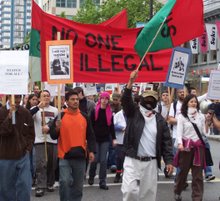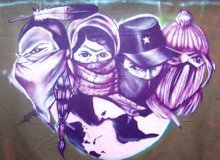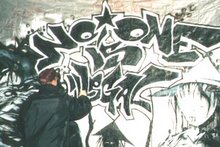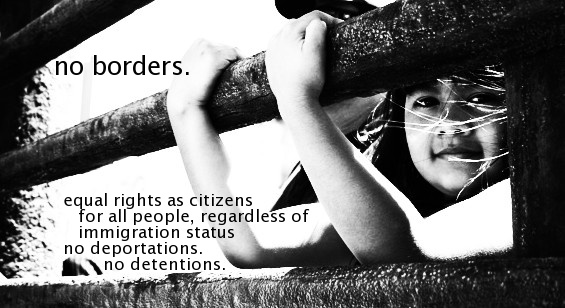"A monumental year" for the people of Six Nations by Hillary Bain Lindsay The Dominion
On January 1, 2007, the people of Six Nations arrived at their Council House, and walked inside. The event did not make media headlines, but the significance of the day was not lost on those crowded into the long line of cars, bearing Iroquois Confederacy and Unity flags, that lead up to the Council House. “Even before Canada declared itself a country, we had a meeting place down here for traditional governance,” says Janie Jamison, one of the spokespeople for Six Nations. For generations, Chiefs representing the Confederacy Council gathered in the Council House to make decisions by consensus, a process often called the oldest participatory democracy on Earth.
In 1924, however, Canada instated the Indian Act and the RCMP raided the Council House, removing the traditional chiefs and clan mothers. In its place the band council system was set up, acting as an arm of the Canadian government. For Jamison, who has never seen herself as Canadian, destroying the traditional government and imposing a new one was Canada’s way of declaring that her culture, her nation, her people “no longer existed.” “What people don’t understand is that we weren’t defeated at that point,” says Jamison.
(Click here to read more)
skip to main |
skip to sidebar







Vancouver - Occupied Coast Salish Territories noii-van@resist.ca / 604-682-3269 ext.7149 www.nooneisillegal.org

Blog Archive
-
▼
2007
(422)
-
▼
February
(65)
- How the pro-Migrant Movement Stopped Fascism and H...
- Immigrant Rights & International Women's Rights: T...
- The US Psychological Torture System is Finally on ...
- Protests Mount Against Canadian Mining Giant
- Transient Servitude: The U.S. Guest Worker Program...
- In Memory of Harriet Nahanee, Age 71
- If Bush is a War Criminal, Then What About the Troops
- Zionism and the United States
- US-Mexico Border Deaths
- Canadian Barrick Gold in Papua New Guinea
- Sanctuary Update
- Bridging The Black-Immigrant Divide
- Immigrant Jail Cell "Suicide"
- Texas Jail Holding 200+ Undocumented Children
- UN: Gaza like apartheid South Africa
- Top Canadian Court Rules Against Security Certifi...
- Imminent Execution of Four Iraqi Women
- Bush and the F-word in 2006: Police State or Progr...
- Nativist Fears of Immigrant Women Giving Birth
- Six Nations Solidarity
- Amnesty Slams Canada over Afghan Detainees
- US soldier pleads guilty to Iraq gang rape, murders
- Iraq: The Rape of Sabrine and Maliki's reaction
- El-Hajj Malik el-Shabazz : 42 years after assassin...
- Showdown Over Texas Immigrant Prisons
- What the Bush Administration Owes Iraq's Refugees
- The “Onkwehonwe Plan” for Turtle Island – We’re Ta...
- Media fall for pro-Israel hate group's "Terror Fre...
- Harriet Tubman -- A Woman Called 'General Moses'
- 8 Reasons to Close Guantánamo Now
- Reports from WSF-Nairobi
- Governor Says No Iraqi Refugees in Ohio
- Scapegoating British Muslims
- How Wealth Creates Poverty
- Cop Watch LA: In Defense of our Immigrant Communities
- Iran: a Chronology of Disinformation
- Great anti-deportation video
- Putting Black Faces on Imperial Aggression
- Violence could force 1M Iraqis to flee homes
- Palestinian call to a comprehensive boycott of Isr...
- Kwakiutl: “We are going to start fighting”
- US: Privatized Prisons for Immigrants
- NYC Action to support Guantanamo North hunger stri...
- Pakistan: Large-scale deportation from Europe likely
- US: 51 held in raids at two Auburn warehouses
- No One is Illegal: Slavery in the New American Cen...
- Anarchist Study of the Rotinonshón:ni Polity
- NIGERIA: Oil Spill Displaces 10 Communities
- Six Nations : "A monumental year"
- Aboriginal Man Appealing Wrongful Conviction
- Iran War Talking Points
- Illegal Immigrants Slain in an Attack in Arizona
- Not Without a Fight: NYC’s food warehouse workers ...
- How Richest Fuel Global Warming - but Poorest Suff...
- White supremacist activity in US flourishes, fuele...
- Bombing Venezuela's Indians
- An appeal to people outside the United States to b...
- Immigration and Privatized Detention in the US
- Safe Third Country Agreement Challenged in Court
- Migrant Boat Awaits Africa Rescue
- Native Students being called "savages"
- BPP Charges based on Torture Confessions
- Queers and Immigration: A Vision Statement
- Canadian immigrants battle chronic low-income
- Homeland Security and the Business of Immigration
-
▼
February
(65)
Labels
- Afghanistan (21)
- Africa (25)
- Anti-Oppression (15)
- Australia (8)
- Canada (105)
- Corporate Globalization (45)
- East Asia (9)
- Environment and Health (26)
- Europe (25)
- Gender (42)
- GLBTQ (7)
- Haiti (9)
- Immigrant/Refugee/Nonstatus (154)
- Imperialism (51)
- Incarceration (63)
- Indigenous (57)
- Iraq (54)
- Labour (34)
- Latin America (41)
- Media (3)
- Middle East (28)
- Palestine (42)
- Police Brutality (4)
- Poverty (17)
- Racism (58)
- Security (67)
- Somalia (7)
- South Asia (25)
- SPP (2)
- US Abroad (91)
- US Home (160)

About Us
No One is Illegal-Vancouver is a grassroots anti-colonial immigrant/refugee rights community collective with leadership from members of migrant and/or racialized backgrounds.
As a movement for self-determination that challenges the ideology of immigration controls, we are in full confrontation with Canadian border policies; denouncing and taking action to combat racial profiling, detention and deportation, the national security apparatus, law enforcement brutality, and exploitative working conditions of migrants. We stand in solidarity with indigenous struggles against colonization across Turtle Island and also place ourselves within the broader movement for global justice struggling against capitalism, homophobia, occupation, patriarchy, poverty, war, and other systems of oppression and exploitation.





No One Is Illegal - Vancouver
Our educational work involves furthering an anti-imperialist, anti-war, and anticapitalist analysis that links the "War on Terror" abroad to the racist "Fortress North America" at home. We struggle for the right for our communities to maintain their livelihoods and resist war, occupation, and displacement, while building alliances and supporting indigenous sisters and brothers fighting theft of land and displacement.
Our work is carried out through various strategies including public awareness events, direct support work with refugees and undocumented migrants, multilingual community political/legal forums, fighting back through rallies and direct actions, and ongoing campaigns and projects.